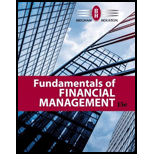
(a)
To explain: T is ordinary shareholder or not.
Introduction:
Direct Stockholder’s Intervention: Most of the shares are owned by institutional investors such as insurance companies pension funds, and rather than individual. These institutional investor control over the firm’s operation and oversee the management operation.
(b)
To explain: The manager should vote its shares or should pass those votes on a pro-rata basis, back to its own shareholders.
Introduction:
Direct Stockholder’s Intervention: Most of the shares are owned by institutional investors such as insurance companies pension funds, and rather than individual. These institutional investor control over the firm’s operation and oversee the management operation.
Want to see the full answer?
Check out a sample textbook solution
Chapter 1 Solutions
Fundamentals of Financial Management (MindTap Course List)
- 6. Calculate the price of a dividend paying stock using the following information, assuming the price is equal to the present value of all future dividends one will receive from owning the stock. (Hint: treat the stock as a growing perpetuity) Dividend $4.50 Growth rate 2% Required return 12% *arrow_forwardFinance question. None please listen if you deslike my answer i will give your also they change rule for sublitt. Also if you will give more deslike bartleby site will be shut down.arrow_forwardProvide true solution.arrow_forward
- Finance question. None please listen if you deslike my answer i will give your. Also if you will give more deslike bartleby site will be shut down.arrow_forwardFinance question. None please listen if you deslike my answer i will give your. Also if you will give more deslike bartleby site will be shut down.arrow_forwardCorrect solnarrow_forward
 EBK CONTEMPORARY FINANCIAL MANAGEMENTFinanceISBN:9781337514835Author:MOYERPublisher:CENGAGE LEARNING - CONSIGNMENT
EBK CONTEMPORARY FINANCIAL MANAGEMENTFinanceISBN:9781337514835Author:MOYERPublisher:CENGAGE LEARNING - CONSIGNMENT
 Auditing: A Risk Based-Approach (MindTap Course L...AccountingISBN:9781337619455Author:Karla M Johnstone, Audrey A. Gramling, Larry E. RittenbergPublisher:Cengage Learning
Auditing: A Risk Based-Approach (MindTap Course L...AccountingISBN:9781337619455Author:Karla M Johnstone, Audrey A. Gramling, Larry E. RittenbergPublisher:Cengage Learning



